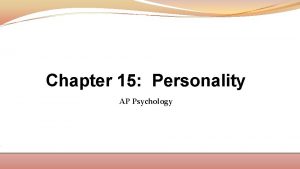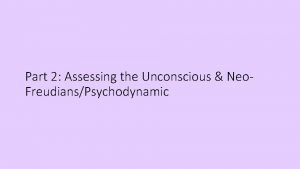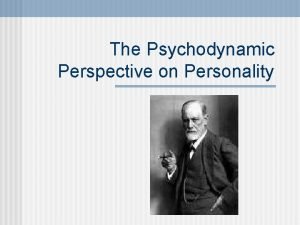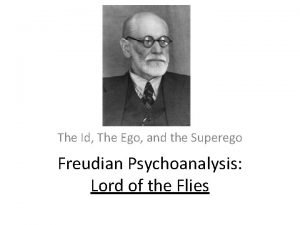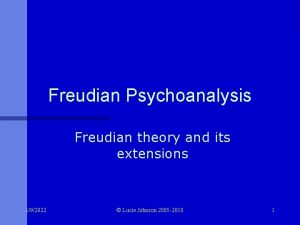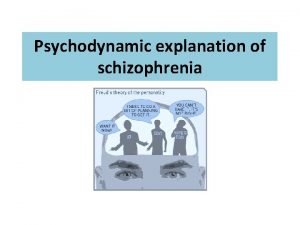Personality Traits Freudian Personality Theory I Personality Traits








- Slides: 8

Personality Traits & Freudian Personality Theory

I. Personality Traits A. Personality Trait: a consistent, long-lasting tendency in thinking, feeling, and / or behavior. B. State: a temporary activation of a particular behavior. C. The Trait Approach to Personality: the idea that people have consistent personality characteristics that can be measured and studied.

D. The “Big Five” Personality Traits 1) Neuroticism: the tendency to experience emotional instability: anxiety, hostility, depression, self-consciousness, impulsiveness, and vulnerability very easily. 2) Extraversion: the tendency to seek stimulation and enjoy the company of other people. 3) Agreeableness: the tendency to be trusting and compassionate rather than distrustful of and antagonistic towards others. 4) Conscientiousness: the tendency to show self-discipline, to be reliable, and to strive for competence and achievement. 5) Openness to Experience: the tendency to enjoy new experiences and new ideas.

II. Freudian Personality Theory A. Psychoanalysis: a method of explaining the workings of personality based on the interplay of conscious and unconscious internal forces. B. Unconscious Mind: contains memories, emotions and thoughts, some of which are illogical or socially unacceptable. C. Catharsis: therapeutic release of pent-up emotional tension.

D. Personality Structure 1) Id: the part that is comprised of all of our biological drives that demand immediate gratification. 2) Ego: the rational, negotiating, and decision-making component of the personality. 3) Superego: the internalized values and rules we receive from our parents and society.

E. A Few Common Defense Mechanisms 1) Fantasy: gratifying frustrated desires in imaginary achievements (“daydreaming” is a common form). 2) Identification: increasing feelings of worth by identifying self with another person or institution, often of illustrious standing. 3) Isolation: cutting off emotional charge from hurtful situations. 4) Humor: the comical expression of negative thoughts that gives pleasure to others. The thoughts retain a portion of their innate distress, but they are “skirted round” by witticism. F. Neurotics can be very sexual.

III. Sexual Attitudes in Relationships A. Reproductive: attitude concerning sex that sex is permissible only for reproductive purposes within marriage. B. Traditional: attitude concerning sex that sex is permissible only within marriage. C. Relational: attitude concerning sex that sex should be accompanied by love or affection, but not necessarily marriage. D. Recreational: attitude concerning sex that whatever feels good and doesn’t hurt anyone is fine. 1) Nymphomania: abnormally excessive and uncontrollable sexual desire in women. 2) Satyriasis: abnormally excessive and uncontrollable sexual desire in men.

IV. Erikson: Young and Middle Adulthood A. Intimacy versus Isolation: in Erikson’s theory, the sixth stage of social & emotional development, in which young adults either make commitments to others or face a possible sense of isolation and consequent self-absorption. B. Generativity versus Stagnation: in Erikson’s theory, the seventh stage of social & emotional development, in which middle-aged adults develop a concern with establishing, guiding, and influencing the next generation or else experience stagnation (a sense of inactivity or lifelessness). C. Two Methods for Expressing Generativity 1) Communal: the expression of generativity involving the care and nurturance of others. 2) Agentic: the expression of generativity involving personal contributions to society.



